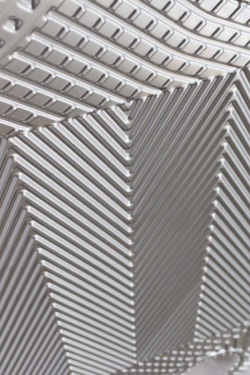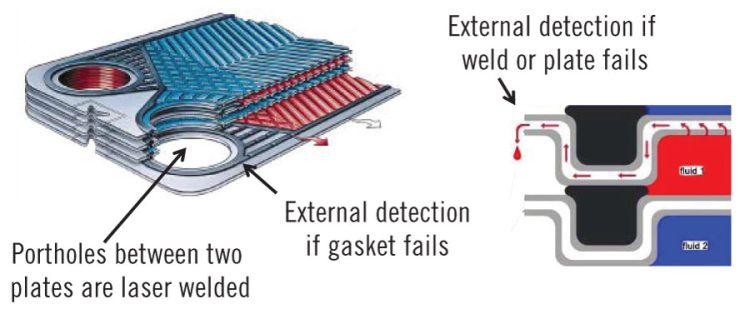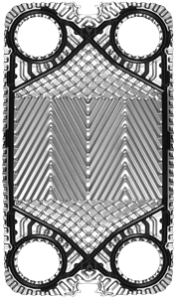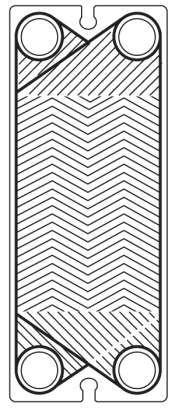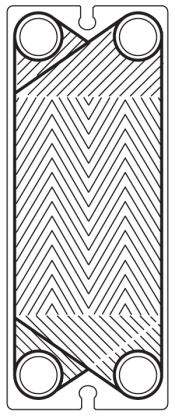Can Double Wall PHEs Be Chemically Cleaned?
Double wall plate and frame heat exchangers (PHEs) are designed to prevent cross-contamination, making them essential for applications like potable water, food processing, and pharmaceuticals.
A common question is: Can double wall PHEs be chemically cleaned?
Yes, double wall PHEs can be effectively cleaned using chemical flushing or Clean-in-Place (CIP) methods, as confirmed by industry leaders like Heat Exchanger Ontario, ensuring efficiency and safety when performed by professionals.
What Are Double Wall PHEs?
Double wall PHEs feature two plates between fluid channels, providing a failsafe against leaks and cross-contamination, as noted by T.H. Industrial Solutions. This design ensures that if a plate develops a pinhole or crack, fluids remain separated, critical for potable water systems under municipal codes.
How Are Double Wall PHEs Chemically Cleaned?
Chemical cleaning methods for double wall PHEs include:
- Clean-in-Place (CIP): Alfa Laval and Hofmann Heat Exchanger endorse CIP systems, which circulate non-toxic cleaning solutions like citric acid or Alfa P-Scale (sulphamic acid-based) to dissolve scale, for organic deposits like fats or biofilms, without disassembly.
- Chemical Flushing: Heat Exchanger Ontario uses portable units with pumps and filters to circulate mild acid or citrus-based solutions for 6–8 hours, effectively removing debris, though less effective for hardened scale.
- Post-Cleaning Rinse: After circulation, clean water flushes out residual chemicals and debris, followed by neutralization (e.g., using Alfa P-Neutra), ensuring environmental compliance.
Effectiveness of Chemical Cleaning
Chemical cleaning is highly effective for double wall PHEs because it:
- Removes Fouling: Dissolves calcium carbonate, rust, and organic matter, restoring heat transfer efficiency and reducing pressure drops (7–10 psi indicates cleaning need), per T.H. Industrial Solutions.
- Maintains Safety: Preserves the double wall’s protective barrier, critical for potable water
- Minimizes Downtime: CIP cleaning, as offered by Hofmann Heat Exchanger, takes 6–8 hours without disassembly, ideal for food and pharmaceutical applications.
Limitations and Considerations
- Hardened Scale: Severe fouling may require combining chemical cleaning with high-pressure water jetting
- Material Compatibility: Chemicals must be compatible with plates (e.g., stainless steel) and gaskets to avoid corrosion
- Environmental Compliance: Spent chemicals must be neutralized and disposed of per regulations
- Professional Expertise: Services from T.H. Industrial Solutions ensure proper chemical selection and flow rates (e.g., 1 ft/sec).
When to Chemically Clean Double Wall PHEs
Chemical cleaning is recommended every 5–6 years or when differential pressure reaches 7–10 psi, indicating fouling. It’s ideal for routine maintenance in potable water or food systems, ensuring compliance with safety codes.
Conclusion
Double wall PHEs can be chemically cleaned using CIP or chemical flushing, effectively removing fouling while maintaining their anti-contamination design. Industry leaders like T.H. Industrial Solutions offer expert services to ensure efficiency and safety.
Can Double Wall HXs Be Cleaned Using High Pressure Water?
Double wall plate and frame heat exchangers (HXs) are designed to prevent cross-contamination, making them critical for applications like potable water, food processing, and pharmaceuticals.
A common question is: Can double wall HXs be cleaned using high pressure water?
Yes, high-pressure water jetting is an effective method for cleaning double wall HXs, particularly for stubborn fouling. However, it requires careful execution to avoid damaging delicate components.
What Are Double Wall HXs?
Double wall HXs feature two plates between fluid channels, ensuring no mixing of fluids if a plate fails, as noted by T.H. Industrial Solutions. This design is vital for potable water systems under municipal codes, making regular cleaning essential to maintain performance and safety.
How Are Double Wall HXs Cleaned with High Pressure Water?
High-pressure water jetting, often at pressures up to 2,500 bar (36,000 psi), removes tough deposits like scale, marine growth, or debris from HX plates. The process typically involves:
- Disassembly: Plates are separated to allow precise jetting, as high-pressure cleaning often requires manual application
- Jetting: A 10 hp gas pressure washer, used by Heat Exchanger Ontario, effectively removes dirt and biofilm, though it may be less effective for scale or rust.
- Inspection: Post-cleaning, dye penetrant testing checks for cracks or pinholes, ensuring plate integrity, a practice emphasized by T.H. Industrial Solutions.
- Reassembly: Plates and gaskets are reinstalled carefully to maintain the double wall’s protective barrier.
Effectiveness of High-Pressure Water Cleaning
High-pressure water cleaning is effective for double wall HXs because it:
- Clears Stubborn Fouling: Removes hardened scale and marine growth, restoring heat transfer efficiency
- Targets Complex Geometries: Penetrates corrugated plate designs for thorough cleaning.
- Reduces Chemical Use: Minimizes reliance on chemicals, eco-friendly when wastewater is managed
Limitations and Considerations
- Risk of Damage: Excessive pressure can harm plates or gaskets, especially in stainless steel or titanium HXs
- Time-Intensive: Disassembly and cleaning can take 2–3 days, compared to faster Clean-in-Place (CIP) methods
- Wastewater Management: Generates significant wastewater, requiring proper treatment
- Professional Expertise: Services from Total Heat Exchanger Solutions, ensure safe cleaning.
When to Use High-Pressure Water Cleaning
High-pressure water cleaning is ideal for double wall HXs with severe fouling, such as marine growth or hardened scale, where CIP or chemical flushing is insufficient. It’s common in industries like power generation or marine applications. For routine maintenance, CIP is often preferred to avoid disassembly.
Conclusion
Double wall HXs can be effectively cleaned with high-pressure water, particularly for tough deposits, but careful execution is needed to protect their anti-contamination design. Industry leaders like T.H. Industrial Solutions offer expert services to ensure efficiency and safety. Trust professionals to maintain your double wall HXs.
Risks of Servicing PHEs That Have 0.4mm Thick Plates
Plate and frame heat exchangers (PHEs) with 0.4mm thick plates are designed for high efficiency in applications like HVAC, food processing, and pharmaceuticals. However, their thin plates make servicing challenging.
A key concern is: What are the risks of servicing PHEs that have 0.4mm thick plates?
Servicing these PHEs, if not done carefully, can lead to plate damage, leaks, or reduced performance, as noted by experts like Alfa Laval and Heat Exchanger Ontario. Understanding these risks is critical for effective maintenance.
Why Are 0.4mm Thick Plates Challenging?
Thin plates (0.4mm) in PHEs, often made of stainless steel or titanium, maximize heat transfer but are delicate, increasing vulnerability during servicing. Improper handling or cleaning methods can compromise their integrity, especially in high-pressure or corrosive environments.
Key Risks of Servicing PHEs with 0.4mm Thick Plates
- Plate Damage from High-Pressure Cleaning: High-pressure water jetting, as used by Heat Exchanger Ontario with a 10 hp gas pressure washer, can dent or puncture 0.4mm plates if pressure exceeds safe limits (e.g., >2,500 bar), leading to leaks or cross-contamination.
- Chemical Corrosion: Incompatible cleaning solutions, like ketones or overly aggressive acids, can corrode thin plates, reducing lifespan and causing pinholes.
- Gasket Damage: Excessive tightening during reassembly or improper chemical exposure can degrade gaskets, causing leaks, a common issue.
- Thermal or Mechanical Stress: Incorrect reassembly or uneven bolt tightening, as warned by T.H. Industrial Solutions, can warp thin plates, impairing sealing and heat transfer efficiency.
- Fouling Recurrence: Incomplete cleaning, especially of scale or biofilms, can lead to persistent performance issues, increasing energy costs
Mitigation Strategies
- Use CIP Systems: Clean-in-Place (CIP) methods, use controlled chemical flushing (e.g., citric acid for 6–8 hours) to minimize physical stress on 0.4mm plates.
- Professional Expertise: Services from T.H. Industrial Solutions ensure proper pressure settings and compatible chemicals, reducing risks.
- Regular Inspections: Dye penetrant testing, detects micro-cracks post-servicing to ensure plate integrity.
- Environmental Compliance: Neutralize and dispose of chemical waste properly, to avoid regulatory issues.
When to Service PHEs with 0.4mm Plates
Service every 5–6 years or when differential pressure reaches 7–10 psi, indicating fouling, per T.H. Industrial Solutions. Routine maintenance prevents severe fouling, reducing the need for aggressive cleaning methods that risk damage.
Conclusion
Servicing PHEs with 0.4mm thick plates carries risks like plate damage, corrosion, and gasket failure, but these can be mitigated with careful methods and expertise. Industry leaders like T.H. Industrial Solutions offer specialized services to safely maintain these delicate systems. Trust professionals to protect your PHEs and ensure optimal performance.
Can Any Thickness of Plate Be Serviced on PHEs?
Plate and frame heat exchangers (PHEs) are critical for efficient heat transfer in industries like HVAC, food processing, and power generation. Their plates, typically ranging from 0.4mm to 1.0mm in thickness, are prone to fouling and wear, requiring regular servicing.
A common question is: Can any thickness of plate be serviced on PHEs?
Yes, PHE plates of various thicknesses can be serviced, but the process requires careful consideration to avoid damage
Understanding PHE Plate Thickness
PHE plates, often made of stainless steel or titanium, vary in thickness (e.g., 0.4mm for high-efficiency units, 0.7mm or thicker for durability. Thinner plates (0.4mm) are more delicate, while thicker plates withstand higher pressures but may be harder to clean due to complex fouling patterns.
How Are PHE Plates Serviced?
Servicing methods for PHE plates include:
- Clean-in-Place (CIP): CIP systems, circulating chemicals like citric acid dissolve scale without disassembly, suitable for all plate thicknesses.
- Chemical Flushing: Heat Exchanger Ontario uses portable units to circulate mild acid solutions for 6–8 hours, effective for 0.4mm to 1.0mm plates, though hardened scale may require additional methods.
- High-Pressure Water Jetting: For severe fouling, T.H. Industrial Solutions employs a 10 hp gas pressure washer, but thin plates (0.4mm) risk denting or puncturing if pressure exceeds safe limits.
- Inspection and Testing: Dye penetrant testing, used by T.H. Industrial Solutions, detects cracks or pinholes, critical for thin plates prone to the “pop can effect” (flexing-induced cracking).
Risks and Considerations by Plate Thickness
- Thin Plates (0.4mm): Highly susceptible to damage from high-pressure jetting or aggressive chemicals Over-tightening during reassembly can deform gasket grooves
- Thicker Plates (0.7mm–1.0mm): More durable but may retain stubborn fouling, requiring combined chemical and mechanical cleaning
- Material Compatibility: Chemicals must match plate materials (e.g., titanium or stainless steel) to avoid corrosion
- Environmental Compliance: Spent chemicals must be neutralized
Effectiveness of Servicing Across Plate Thicknesses
Servicing restores efficiency by removing fouling, which can cause a 20% thermal efficiency loss even at paper-thin levels. CIP is effective for all thicknesses, while high-pressure cleaning suits thicker plates better. Regular servicing every 5–6 years or at 7–10 psi differential pressure prevents severe fouling
Conclusion
PHE plates of any thickness can be serviced using CIP, chemical flushing, or high-pressure jetting, but thinner plates require extra care to avoid damage. Industry leaders like T.H. Industrial Solutions offer tailored services to ensure safe, effective maintenance.
Can Water Hammer or Spiking Damage Plate & Frame Heat Exchangers?
Plate and frame heat exchangers (PHEs) are widely used in industries like HVAC, food processing, and power generation for efficient heat transfer. However, operational issues like water hammer or pressure spiking can pose significant risks.
A common question is: Can water hammer or spiking damage plate & frame heat exchangers?
Yes, water hammer and pressure spiking can damage PHEs, particularly affecting gaskets and plates, as noted by experts like T.H. Industrial Solutions and Alfa Laval. Understanding these risks is crucial for proper maintenance and operation.
What Are Water Hammer and Spiking in PHEs?
Water hammer is a sudden pressure surge caused by rapid valve closure or flow changes, creating shockwaves in the system. Spiking refers to abrupt pressure or temperature fluctuations, often exceeding design limits. Both can stress PHE components, especially thin plates (e.g., 0.4mm) and gaskets
Risks of Water Hammer and Spiking on PHEs
- Gasket Damage: Water hammer can force gaskets out of plate grooves, causing leaks, particularly in PHEs with 0.4mm plates, which are highly susceptible to deformation
- Plate Deformation: Pressure spikes can dent or puncture thin plates, compromising heat transfer and risking cross-contamination, as noted by Heat Exchanger Ontario.
- Seal Failure: Spiking from rapid pressure changes (e.g., >150 psig/min) can break gasket bonds or deform grooves, leading to leaks
- Reduced Lifespan: Repeated surges accelerate wear on plates and gaskets, shortening PHE lifespan, especially in high-pressure systems, as cautioned by industry standards.
Mitigation Strategies
- Gradual Valve Operation: Open and close valves slowly during startup to prevent water hammer
- Install Protective Devices: Use relief valves, pulsation dampers, or arrestors to absorb pressure spikes, per industry best practices.
- Use Strainers: Upstream filters remove debris that exacerbates pressure issues, protecting PHEs
- Regular Inspections: Monitor pressure drops (7–10 psi indicates fouling) and perform dye penetrant testing to detect plate damage
When to Service PHEs
Service PHEs every 5–6 years or when differential pressure reaches 7–10 psi, indicating fouling or potential damage from surges. Regular maintenance prevents escalation of water hammer or spiking issues.
Conclusion
Water hammer and pressure spiking can significantly damage plate and frame heat exchangers by affecting gaskets and plates, leading to leaks and reduced efficiency. Industry leaders like T.H. Industrial Solutions offer expert maintenance to mitigate these risks. Trust professionals to protect your PHEs and ensure optimal performance.
WHEN SHOULD A PLATE & FRAME HEAT EXCHANGER BE SERVICED?
As a heat exchanger becomes fouled with dirt, debris or scale, often the modulating valve provides additional hot or cold liquid to help compensate for the loss of efficiency of the heat exchanger.
Over time the control valve will continue to open fully. Unfortunately, on the hottest or coldest days, even with the valve fully open the heat exchanger cannot meet the thermal transfer requirements and the situation becomes critical.
Monitoring just the operating temperature provides a false sense of security. Recording the difference in the outlet and inlet pressures provides a more accurate result of the amount of fouling.
Fouling equal to the thickness of a piece of paper represents a 20% loss of thermal efficiency. In addition, the energy cost for pumps increases since the pump must work harder to overcome the increased pressure resistance through the PHE
Can Double Wall Plate & Frame PHEs Be Cleaned or Serviced?
Double wall plate and frame heat exchangers (PHEs) are specialized systems designed to prevent cross-contamination, making them ideal for applications like potable water, food processing, and pharmaceuticals.
A common question is: Can double wall plate & frame PHEs be cleaned or serviced?
Yes, double wall PHEs can be effectively cleaned and serviced using methods like Clean-in-Place (CIP), chemical flushing, or mechanical cleaning, ensuring efficiency and compliance with safety standards.
What Are Double Wall PHEs?
Double wall PHEs feature two plates between fluid channels, providing a failsafe against leaks and cross-contamination, as highlighted by T.H. Industrial Solutions. If a plate develops a pinhole or crack, the double wall design prevents fluid mixing, making them critical for potable water systems under municipal codes, as noted in industry standards.
How Are Double Wall PHEs Cleaned and Serviced?
Cleaning and servicing double wall PHEs involve tailored methods to maintain their integrity:
- Clean-in-Place (CIP): Alfa Laval and Hofmann Heat Exchanger endorse CIP systems, circulating cleaning solutions like citric acid or sodium hydroxide to remove scale or organic deposits without disassembly, ideal for routine maintenance.
- Chemical Flushing: Heat Exchanger Ontario uses portable units with pumps and filters to circulate mild acid or citrus-based solutions for 6–8 hours, effectively clearing debris, though less effective for hardened scale.
- Mechanical Cleaning: For severe fouling, plates are disassembled and cleaned with high-pressure water or soft brushes, ensuring no damage to plates or gaskets.
- Inspection and Testing: Post-cleaning, dye penetrant testing, used by T.H. Industrial Solutions, detects cracks or pinholes to ensure reliability.
Effectiveness of Cleaning Double Wall PHEs
- Restores Efficiency: Cleaning removes scale and biofilms, reducing pressure drops (7–10 psi indicates service need) and improving heat transfer.
- Ensures Safety: Servicing maintains the double wall’s protective barrier, critical for potable water.
- Prolongs Lifespan: Regular maintenance, prevents corrosion and gasket wear, ensuring compliance with regulations.
Limitations and Considerations
- Material Compatibility: Cleaning agents must suit plate and gasket materials to avoid corrosion.
Severe Fouling: Hardened scale may require disassembly and mechanical cleaning, increasing labor compared to CIP, per industry standards.
Environmental Compliance: Spent chemicals must be neutralized.
Expertise Required: Services from T.H. Industrial Solutions ensure safe cleaning and proper flow rates (e.g., 1 ft/sec).
When to Clean or Service Double Wall PHEs
Service is recommended every 5–6 years or when differential pressure reaches 7–10 psi, indicating fouling. Double wall PHEs in potable water systems require regular maintenance to meet municipal codes, ensuring no cross-contamination risks.
Conclusion
Double wall plate and frame PHEs can be effectively cleaned and serviced using CIP, chemical flushing, or mechanical methods, maintaining efficiency and safety. Industry leaders like T.H. Industrial Solutions provide expert services tailored to double wall PHEs. Trust professionals to ensure compliance and optimal performance.
How Effective Is Using High Pressure Water to Clean Plate & Frame Heat Exchangers?
Plate and frame heat exchangers (PHEs) are vital for efficient heat transfer in industries like HVAC, food processing, and power generation. Fouling from scale, rust, or organic matter can reduce performance, increase energy costs, and risk system failures.
A common question is: How effective is using high pressure water to clean plate & frame heat exchangers?
High-pressure water jetting is highly effective for removing stubborn deposits, but its success depends on proper execution
What Is High-Pressure Water Cleaning for PHEs?
High-pressure water jetting uses a concentrated water stream, often at pressures up to 2,500 bar (36,000 psi), to dislodge tough fouling like scale, marine growth, or debris from PHE plates. This method, is particularly effective for severe fouling that Clean-in-Place (CIP) or chemical flushing cannot fully address. It often requires disassembling the PHE for precise cleaning.
Effectiveness of High-Pressure Water Cleaning
High-pressure water cleaning is effective for PHEs because it:
- Removes Stubborn Deposits: It clears hardened scale, calcium carbonate, and biological fouling, restoring heat transfer efficiency methods.
- Targets Complex Geometries: The high-pressure stream reaches tight spaces and corrugated plate designs, ensuring thorough cleaning.
- Reduces Chemical Use: It minimizes reliance on harsh chemicals, making it eco-friendly when wastewater is managed properly.
How High-Pressure Water Cleaning Works
- Disassembly: PHEs are dismantled to access plates, as high-pressure cleaning typically requires manual application, per industry standards.
- Jetting: Technicians use high-pressure water jets, as practiced by Heat Exchanger Ontario, to remove debris without damaging plates.
- Rinsing and Inspection: Plates are rinsed and checked for damage (e.g., cracks or pinholes) using dye penetrant testing
- Reassembly: Plates and gaskets are reinstalled, ensuring proper sealing, as emphasized.
Limitations of High-Pressure Water Cleaning
- Risk of Damage: Excessive pressure can harm delicate plates or gaskets, especially in stainless steel or titanium PHEs
- Time and Labor: Disassembly and cleaning can take 2–3 days, as noted in traditional methods, compared to faster CIP systems.
- Wastewater Management: High-pressure cleaning generates significant wastewater, requiring proper treatment to meet environmental regulations
Best Practices for High-Pressure Water Cleaning
- Combine with Chemical Cleaning: Pair high-pressure jetting with chemical flushing for severe fouling
- Use Professional Services: Experts like T.H. Industrial Solutions ensure proper pressure settings to protect components.
- Monitor Fouling: Schedule cleaning when differential pressure reaches 7–10 psi, indicating fouling
- Environmental Compliance: Manage wastewater to comply with regulations
When to Use High-Pressure Water Cleaning
High-pressure water cleaning is ideal for PHEs with severe fouling, such as marine growth or hardened scale, where CIP or chemical methods are insufficient. It’s commonly used in industries like power generation or marine applications. For routine maintenance, CIP or chemical flushing may be preferred to avoid disassembly,
Conclusion
High-pressure water cleaning is highly effective for cleaning plate and frame heat exchangers, particularly for tough deposits, but requires expertise to avoid damage and manage wastewater. Industry leaders like T.H. Industrial Solutions offer professional services to ensure safe, efficient cleaning.
Can PHEs Be Cleaned Using High Pressure Water?
Plate heat exchangers (PHEs) are vital for efficient heat transfer in industries like HVAC, food processing, and power generation. Fouling from scale, rust, or organic matter can reduce their performance, increasing energy costs and risking system downtime.
A common question is: Can PHEs be cleaned using high pressure water?
Yes, high-pressure water jetting is an effective cleaning method for PHEs, particularly for stubborn fouling, but it requires careful execution to avoid damaging delicate components. Industry experts like T.H. Industrial Solutions provide specialized services to ensure safe and effective cleaning.
What Is High-Pressure Water Cleaning for PHEs?
High-pressure water jetting uses a concentrated stream of water, typically at pressures up to 2,500 bar (36,000 psi), to dislodge tough deposits like scale, marine fouling, or debris from PHE plates. This method is particularly effective for severe fouling that Clean-in-Place (CIP) or chemical flushing cannot fully address, such as mussels or hardened calcium carbonate, as noted in industrial application
Effectiveness of High-Pressure Water Cleaning
High-pressure water cleaning is highly effective for PHEs because it:
- Removes Stubborn Deposits: The forceful water stream clears scale, rust, and biological fouling, restoring heat transfer efficiency, as emphasized by Total Heat Exchanger Solutions for industrial applications.
- Targets Complex Geometries: It reaches tight spaces and intricate plate designs, ensuring thorough cleaning.
- Reduces Chemical Use: High-pressure jetting minimizes reliance on chemicals, making it environmentally friendly when wastewater is properly managed
- Heat Exchanger Ontario uses a 10 hp gas pressure washer to clean PHE plates, effectively removing dirt and biofilm, though it may be less effective for scale and rust buildup compared to chemical methods.
How High-Pressure Water Cleaning Works
- Disassembly: PHEs are often disassembled to access plates, as high-pressure cleaning typically requires manual or semi-automated application, per industry standards.
- Jetting: Technicians use high-pressure water jets to clean plates, as offered by Heat Exchanger Ontario, ensuring debris is dislodged without damaging surfaces.
- Inspection: Post-cleaning checks, such as dye penetrant testing, ensure plates are free of cracks or pinholes, a practice emphasized by Heat Exchanger Ontario
- Waste Management: Wastewater is collected and treated to meet environmental regulations
Limitations of High-Pressure Water Cleaning
- Risk of Damage: Excessive pressure can harm delicate plates or gaskets, especially in stainless steel or titanium PHEs, requiring expert control
- Time-Intensive: Disassembly and cleaning can take 2–3 days per exchanger, as seen in traditional methods, compared to faster CIP methods.
- Wastewater Concerns: High-pressure cleaning generates significant wastewater, increasing disposal costs and environmental impact, as highlighted in industry practices.
Best Practices for High-Pressure Water Cleaning
- Combine with Chemical Cleaning: For severe fouling, pair high-pressure jetting with chemical flushing
- Use Professional Services: Experts ensure proper pressure settings and protect gaskets during cleaning.
- Monitor Wastewater: Proper containment and treatment of runoff water are critical to comply with environmental regulations
- Regular Maintenance: Schedule cleaning every 1–3 years, depending on fouling severity, to maintain efficiency
When to Use High-Pressure Water Cleaning
High-pressure water cleaning is ideal for PHEs with severe fouling, such as marine growth or hard scale, where CIP or chemical methods are insufficient. It’s commonly used in industries like power generation or marine applications. For routine maintenance, CIP or chemical flushing may be preferred to avoid disassembly.
Conclusion
High-pressure water cleaning is an effective solution for cleaning plate heat exchangers, particularly for tough deposits, but it requires expertise to prevent damage and manage wastewater. Companies like T.H. Industrial Solutions offer professional services to ensure safe, efficient cleaning tailored to your PHE’s needs.
Can PHEs Be Cleaned Using Chemical Flushing?
Plate heat exchangers (PHEs) are vital for efficient heat transfer in industrial, HVAC, and marine systems. Over time, PHEs can accumulate scale, rust, or organic debris, which reduces performance and increases energy costs.
A common question is: Can PHEs be cleaned using chemical flushing?
The answer is yes—chemical flushing is a proven and effective method for cleaning PHEs when performed by professionals with the right expertise and equipment.
T.H. Industrial Solutions Inc. (THS) has been servicing industrial plate and frame heat exchangers as with shell and tube heat exchangers. Professionally solving process problems across Canada since 2009. THS head office is located in Pickering, Ontario with a 6,000 square foot service center in Hamilton, Ontario.
Today there are fewer qualified people in this industry that know the products and understand the applications. Utilizing hands on experience and knowledge that has been gained by our THS sales and service technicians for over the past 30 years, we will take the time to understand what you require and strive to provide a prompt, educated and accurate response at a competitive price.
Our Heat Exchanger Cleaning Services, along with heat exchanger gasket replacement systems, and knowledge of heat exchanger gasket materials make THS your Industrial Heat Exchanger Service Solution
HEAD OFFICE
1550 Bayly Street, Unit 15
Pickering, ON L1W 3W1
T 905 831-4963
SERVICE CENTER
76 Harlowe Road, Unit 4 - 7
Hamilton, ON L8W 3R6
T 905 318-0777
F 905-318-8422
Contact THS Service
T. H. Industrial Solutions
Head Office
1550 Bayly Street, Unit 15
Pickering, ON L1W 3W1
T. H. Industrial Solutions
Service Center
76 Harlowe Road, Unit 4 - 7
Hamilton, ON L8W 3R6
